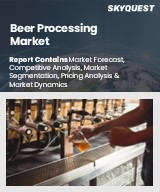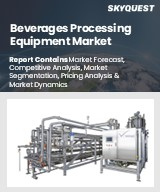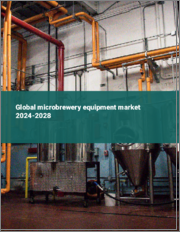
|
시장보고서
상품코드
1627733
세계의 양조 장비 시장 : 예측(2025-2030년)Global Brewery Equipment Market - Forecasts from 2025 to 2030 |
||||||
양조 장비 시장은 연평균 8.76% 성장하여 2025년 206억 3,200만 달러에서 2030년에는 313억 9,900만 달러에 달할 것으로 예상됩니다.
맥주 생산량은 전 세계적으로 맥주 생산량이 증가하고 있으며, 이는 중산층과 저소득층의 가처분 소득 증가로 인한 수요 증가에 따라 맥주의 인기가 높아짐에 따라 증가하고 있습니다. 사람들은 프리미엄 맥주에 더 많은 지출을 하고 있습니다. 이처럼 전 세계 맥주 소비 증가는 맥주 생산량 증가로 이어져 맥주 양조 장비에 대한 수요를 증가시키고 있습니다. 또한, 생산량 증가와 수요 증가에 대응하기 위한 소규모 양조장 및 양조장 증가는 세계 양조 장비 시장 성장에 더욱 박차를 가하고 있습니다.
양조 설비 시장 성장 촉진요인
- 전통맥주보다 수제맥주를 선호하는 경향
전통 맥주보다 수제 맥주에 대한 선호도가 높아지는 것도 양조 장비 시장의 성장을 견인하고 있습니다. 수제 맥주는 기존 맥주와 차별화되는 다양한 스타일을 가지고 있습니다. 또한, 자극적인 맛과 우수한 알코올 도수를 가지고 있습니다. 인디언 페일 에일(IPA), 라거, 포터 등 다양한 유형의 맥주가 사용되며, 더 나은 제법으로 발효됩니다. 또한, 수제맥주에는 대량 생산 맥주에는 없는 다양한 제품과 맛이 준비되어 있습니다. 이 때문에 수제맥주 양조장 설립과 수제맥주 생산이 증가하면서 양조 장비 시장 성장에 긍정적인 영향을 미치고 있습니다.
전체적으로 2023년 미국의 맥주 생산량과 수입량은 5% 감소했지만, 수제 맥주 제조업체의 판매량은 1% 감소했지만, 미국 맥주 시장에서 소규모 및 독립 맥주 제조업체의 판매량 점유율은 13.3%로 상승했습니다. 크래프트 맥주의 소매 달러 매출은 3% 증가한 289억 달러로 현재 1,170억 달러 규모의 미국 맥주 시장(이전에는 1,150억 달러)의 24.7%를 차지합니다. 달러 매출 증가의 가장 큰 요인은 가격 인상과 유통에 비해 현장 판매량이 소폭 증가했기 때문입니다.
또한, 맥주 제조업체와 양조장들 사이에서 유리한 수제 맥주 시장으로의 전환에 대한 인식이 높아짐에 따라 시장 참여자들은 양조 장비의 성장을 강화할 수 있는 큰 기회를 얻게 되었습니다. 기존 시설의 확장 및 양조장용 자동 양조 장비와 같은 최신 기술에 대한 투자 증가는 예측 기간 동안 이 시장의 성장을 더욱 촉진할 것으로 예상됩니다.
양조설비 시장은 세계 5개 지역으로 구분된다:
지역별로 보면 양조 장비 시장은 북미, 남미, 유럽, 중동 및 아프리카, 아시아태평양으로 나뉩니다. 북미에서는 여러 가지 중요한 요인들이 이 산업을 주도하고 있습니다. 수제 맥주 문화의 부상으로 지역 양조장 및 수제 맥주 양조장이 호황을 누리고 있으며, 특수 장비를 사용하여 독특하고 고품질의 맥주를 생산하고 있습니다. 그 결과, 소비자들의 프리미엄 맥주와 스페셜티 맥주에 대한 선호도가 높아지면서 복잡하고 풍미가 풍부한 맥주를 만들기 위해 고급 양조 장비에 대한 수요가 증가하고 있습니다.
자동화 및 디지털 솔루션과 같은 새로운 기술의 발전으로 효율성과 비용 절감, 그리고 맥주 품질이 더욱 향상되고 있습니다. 지속가능성에 대한 관심이 높아짐에 따라 양조 기계는 더 에너지 효율적이고 환경적으로 안전해야 합니다. 정부의 규제 완화, 소규모 사업자에 대한 특별한 배려 등 정부의 우호적인 정책적 지원도 양조장 확장에 기여하고 있습니다.
아시아태평양의 양조 장비 시장은 특히 중국, 인도, 한국 등 신흥 경제권의 맥주 소비량 증가와 같은 요인에 의해 주도되고 있습니다. 수제 맥주의 인기가 눈에 띄게 증가하고 있으며, 이에 따라 수제 맥주 전용 장비에 대한 수요가 증가하고 있습니다. 또한, 가처분 소득 증가와 라이프스타일의 변화로 인해 알코올 소비가 증가하면서 양조 장비에 대한 수요가 증가하고 있습니다.
이 보고서를 구매해야 하는 이유
- 통찰력 있는 분석 : 고객 부문, 정부 정책 및 사회경제적 요인, 소비자 선호도, 산업별, 기타 하위 부문에 중점을 두고 주요 지역뿐만 아니라 신흥 지역까지 포괄하는 상세한 시장 인사이트을 얻을 수 있습니다.
- 경쟁 환경: 세계 주요 기업들이 채택하고 있는 전략적 전략을 이해하고, 적절한 전략을 통한 시장 침투 가능성을 파악할 수 있습니다.
- 시장 성장 촉진요인과 미래 동향 : 역동적인 요인과 매우 중요한 시장 동향, 그리고 이들이 향후 시장 발전을 어떻게 형성할 것인지에 대해 알아봅니다.
- 행동 가능한 제안: 역동적인 환경 속에서 새로운 비즈니스 스트림과 수익을 발굴하기 위한 전략적 의사결정에 통찰력을 활용합니다.
- 다양한 사용자에 대응: 스타트업, 연구기관, 컨설턴트, 중소기업, 대기업에 유익하고 비용 효율적임.
어떤 용도로 사용되나요?
산업 및 시장 검토, 사업 기회 평가, 제품 수요 예측, 시장 진출 전략, 지리적 확장, 설비 투자 결정, 규제 프레임워크 및 영향, 신제품 개발, 경쟁의 영향
분석 범위
- 과거 데이터 및 예측(2022-2030년)
- 성장 기회, 과제, 공급망 전망, 규제 프레임워크, 고객 행동 및 트렌드 분석
- 경쟁사 포지셔닝, 전략 및 시장 점유율 분석
- 수익 성장률 및 예측 분석 : 부문별, 지역별(국가별)
- 기업 프로파일링(전략, 제품, 재무정보, 주요 동향 등)
목차
제1장 서론
- 시장 개요
- 시장의 정의
- 분석 범위
- 시장 세분화
- 통화
- 전제조건
- 기준연도 및 예측연도 타임라인
- 이해관계자에 있어서의 주요 이점
제2장 분석 방법
- 분석 디자인
- 분석 프로세스
제3장 주요 요약
- 주요 조사 결과
- 애널리스트의 견해
제4장 시장 역학
- 시장 성장 촉진요인
- 시장 성장 억제요인
- Porter의 Five Forces 분석
- 업계 밸류체인 분석
제5장 세계의 양조 설비 시장 : 설비 유형별
- 서론
- 양조용 케틀
- 구리 케틀
- 스테인리스 케틀
- 발효 탱크
- 기타
제6장 세계의 양조 설비 시장 : 양조소 유형별
- 서론
- 향토 맥주 양조소
- 대형 맥주 회사
- 크래프트 맥주 양조소
제7장 세계의 양조 설비 시장 : 지역별
- 세계 개요
- 북미
- 미국
- 캐나다
- 멕시코
- 남미
- 브라질
- 아르헨티나
- 기타 남미
- 유럽
- 영국
- 독일
- 프랑스
- 이탈리아
- 스페인
- 기타 유럽
- 중동 및 아프리카
- 사우디아라비아
- 아랍에미리트(UAE)
- 기타 중동 및 아프리카
- 아시아태평양
- 중국
- 인도
- 일본
- 한국
- 대만
- 태국
- 인도네시아
- 기타 아시아태평양
제8장 경쟁 환경과 분석
- 주요 기업과 전략 분석
- 시장 점유율 분석
- 기업인수합병(M&A), 합의, 사업 협력
- 경쟁 대시보드
제9장 기업 개요
- Alfa Laval
- GEA Group Aktiengesellschaft
- Paul Mueller Company
- Praj Industries
- Meura
- Criveller Group
- Kaspar Schulz
- Ningbo Lehui
- Hypro Engineers
- Czech Brewery System
The global brewery equipment market is projected to grow at a CAGR of 8.76% to reach a value of US$31.399 billion by 2030, from US$20.632 billion in 2025.
The production of beer is increasing globally to meet the increasing demand owing to the popularity of beer as a recreational beverage, which in turn is facilitated by the increasing disposable income of the middle-income and low-income populations. People are spending more on premium beer. Thus, growing global beer consumption is encouraging more beer production, which, in turn, is driving the demand for brewery equipment. Additionally, the increasing number of microbreweries and breweries to increase production and meet the rising demand is further adding to the market growth of brewery equipment worldwide.
Global brewery equipment market drivers
- Preference for craft beer over traditional beer
A growing preference for craft beer over traditional beers is also propelling the market growth of brewery equipment since craft beer is considered a much more premium and artisanal beverage. It has a variety of styles that set it apart from traditional beer. In addition, it has stimulating flavor profiles and better alcohol content. Different types of beer used, such as Indian Pale Ales (IPAs), Lagers, and Porters, among others, are fermented using better processes. Moreover, a variety of products and tastes are available for craft beers, which are absent in mass-produced ones. This leads to an increase in the setting up of craft breweries and craft beer production, thus positively impacting the market growth of brewery equipment.
Overall, U.S. beer production and imports were down 5% in 2023, while craft brewer volume sales declined by 1%, raising small and independent brewers' share of the U.S. beer market by volume to 13.3%. Retail dollar sales of craft increased 3% to $28.9 billion and now represent 24.7% of the $117 billion U.S. beer market (previously $115 billion). The biggest drivers of the higher dollar sales increase were price increases and slightly stronger onsite sales growth compared with distribution.
Moreover, the growing awareness among beer producers and breweries about transitioning into the lucrative market for craft breweries presents a significant opportunity for market players to enhance the growth of brewery equipment. Expanding existing facilities and rising investments in the latest technologies, such as automated brewing equipment for breweries, will further propel this market's growth during the forecast period.
The global brewery equipment market is segmented into five regions worldwide:
Geography-wise, the global brewery equipment market is divided into North America, South America, Europe, the Middle East and Africa, and Asia Pacific. Many key factors are driving this industry in North America. Rising craft beer culture is booming in microbreweries and craft breweries, producing unique and quality beers using specialized equipment. This, in turn, leads to an increase in premium and specialty beer preference in consumers, thereby elevating demand for high-end brewing equipment in terms of creating complex and flavorful brews.
Further improvement in efficiency and a further cost reduction, plus an increase in beer quality, has been made through newer technology advancements such as automation and digital solutions. Higher interest in sustainability has pressured brewing machinery to be more energy-efficient and safe for the environment. Support from favorable government policies such as looser licensing laws and special care taken to favor small-scale enterprise businesses also contribute to brewery expansion.
The Asia Pacific brewery equipment market is driven by factors such as a boost in beer consumption, specifically in the emerging economies of China, India, and South Korea. The popularity of craft beer has increased significantly, thus increasing the demand for microbrewery-specific equipment. Additionally, the rise in disposable incomes and changing lifestyles have increased alcohol consumption, thereby increasing the demand for brewing equipment.
Reasons for buying this report:-
- Insightful Analysis: Gain detailed market insights covering major as well as emerging geographical regions, focusing on customer segments, government policies and socio-economic factors, consumer preferences, industry verticals, other sub- segments.
- Competitive Landscape: Understand the strategic maneuvers employed by key players globally to understand possible market penetration with the correct strategy.
- Market Drivers & Future Trends: Explore the dynamic factors and pivotal market trends and how they will shape up future market developments.
- Actionable Recommendations: Utilize the insights to exercise strategic decision to uncover new business streams and revenues in a dynamic environment.
- Caters to a Wide Audience: Beneficial and cost-effective for startups, research institutions, consultants, SMEs, and large enterprises.
What do businesses use our reports for?
Industry and Market Insights, Opportunity Assessment, Product Demand Forecasting, Market Entry Strategy, Geographical Expansion, Capital Investment Decisions, Regulatory Framework & Implications, New Product Development, Competitive Intelligence
Report Coverage:
- Historical data & forecasts from 2022 to 2030
- Growth Opportunities, Challenges, Supply Chain Outlook, Regulatory Framework, Customer Behaviour, and Trend Analysis
- Competitive Positioning, Strategies, and Market Share Analysis
- Revenue Growth and Forecast Assessment of segments and regions including countries
- Company Profiling (Strategies, Products, Financial Information, and Key Developments among others)
The global brewery equipment market is segmented and analyzed as follows:
By Equipment Type
- Brew Kettles
- Copper Kettles
- Stainless Steel Kettles
- Fermentation Tanks
- Others
By Brewery Type
- Microbreweries
- Macro Breweries
- Craft Breweries
By Geography
- North America
- USA
- Canada
- Mexico
- South America
- Brazil
- Argentina
- Rest of South America
- Europe
- United Kingdom
- Germany
- France
- Italy
- Spain
- Rest of Europe
- Middle East and Africa
- Saudi Arabia
- UAE
- Rest of the Middle East and Africa
- Asia Pacific
- China
- India
- Japan
- South Korea
- Taiwan
- Thailand
- Indonesia
- Rest of Asia-Pacific
TABLE OF CONTENTS
1. INTRODUCTION
- 1.1. Market Overview
- 1.2. Market Definition
- 1.3. Scope of the Study
- 1.4. Market Segmentation
- 1.5. Currency
- 1.6. Assumptions
- 1.7. Base and Forecast Years Timeline
- 1.8. Key benefits for the stakeholders
2. RESEARCH METHODOLOGY
- 2.1. Research Design
- 2.2. Research Process
3. EXECUTIVE SUMMARY
- 3.1. Key Findings
- 3.2. Analyst View
4. MARKET DYNAMICS
- 4.1. Market Drivers
- 4.2. Market Restraints
- 4.3. Porter's Five Forces Analysis
- 4.3.1. Bargaining Power of Suppliers
- 4.3.2. Bargaining Power of Buyers
- 4.3.3. The Threat of New Entrants
- 4.3.4. Threat of Substitutes
- 4.3.5. Competitive Rivalry in the Industry
- 4.4. Industry Value Chain Analysis
5. GLOBAL BREWERY EQUIPMENT MARKET BY EQUIPMENT TYPE
- 5.1. Introduction
- 5.2. Brew Kettles
- 5.3. Copper Kettles
- 5.4. Stainless Steel Kettles
- 5.5. Fermentation Tanks
- 5.6. Others
6. GLOBAL BREWERY EQUIPMENT MARKET BY BREWERY TYPE
- 6.1. Introduction
- 6.2. Microbreweries
- 6.3. Macro Breweries
- 6.4. Craft Breweries
7. GLOBAL BREWERY EQUIPMENT MARKET BY GEOGRAPHY
- 7.1. Global Overview
- 7.2. North America
- 7.2.1. United States
- 7.2.2. Canada
- 7.2.3. Mexico
- 7.3. South America
- 7.3.1. Brazil
- 7.3.2. Argentina
- 7.3.3. Rest of South America
- 7.4. Europe
- 7.4.1. United Kingdom
- 7.4.2. Germany
- 7.4.3. France
- 7.4.4. Italy
- 7.4.5. Spain
- 7.4.6. Rest of Europe
- 7.5. Middle East and Africa
- 7.5.1. Saudi Arabia
- 7.5.2. United Arab Emirates
- 7.5.3. Rest of the Middle East and Africa
- 7.6. Asia-Pacific
- 7.6.1. China
- 7.6.2. India
- 7.6.3. Japan
- 7.6.4. South Korea
- 7.6.5. Taiwan
- 7.6.6. Thailand
- 7.6.7. Indonesia
- 7.6.8. Rest of Asia-Pacific
8. COMPETITIVE ENVIRONMENT AND ANALYSIS
- 8.1. Major Players and Strategy Analysis
- 8.2. Market Share Analysis
- 8.3. Mergers, Acquisitions, Agreements, and Collaborations
- 8.4. Competitive Dashboard
9. COMPANY PROFILES
- 9.1. Alfa Laval
- 9.2. GEA Group Aktiengesellschaft
- 9.3. Paul Mueller Company
- 9.4. Praj Industries
- 9.5. Meura
- 9.6. Criveller Group
- 9.7. Kaspar Schulz
- 9.8. Ningbo Lehui
- 9.9. Hypro Engineers
- 9.10. Czech Brewery System


















